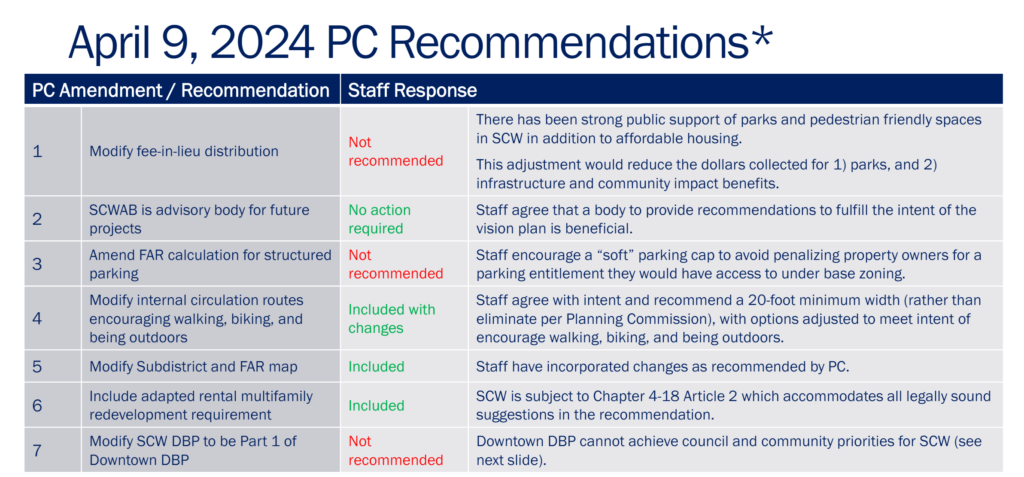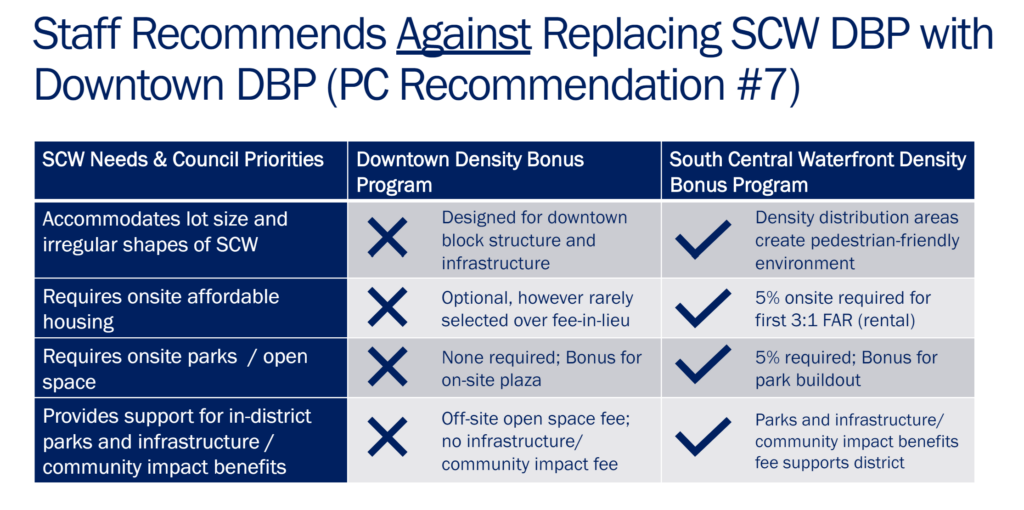Ahead of May vote, Council hears staff feedback for revised South Central Waterfront plan
Friday, April 26, 2024 by
Chad Swiatecki Planning Department staff explained to a portion of City Council members this week why they intend to move forward with only about half of the Planning Commission’s suggested changes to the South Central Waterfront Plan.
At a combined meeting of the Mobility Committee and the Housing and Planning Committee, the message from principal planner April Geruso was that incorporating portions of the existing Downtown Density Bonus Program is too broad and is a “one size fits all” solution for two portions of the city that have very different needs.
Earlier this month, the Planning Commission voted to support the long-gestating plan and added 13 amendments that covered matters such as how fee-in-lieu payments could be structured, how to calculate floor area ratio in some specific cases and extending the existing Downtown Density Bonus Program to cover the entire waterfront district.
The presentation made this week showed staff directly opposed four of the amendments and found three that went beyond the scope of the plan. The other six are being acted upon or have already been completed.

Credit: City of Austin
“Ultimately, the Downtown Density Bonus Program simply does not meet the needs of the South Central Waterfront,” Geruso said. “Believe me, if it were as simple as such, we would have definitely proposed that versus working tirelessly to try and get something with the myriad of community benefits we’ve been able to achieve with the draft we’ve got in front of us today.”

Credit: City of Austin
The update was one of the final engagement steps before the revised plan is expected to be considered for adoption by Council next month.
The plan spells out how parcels would be split to accommodate pedestrians and vehicles and how developers can use public benefits such as affordable housing or park space to increase the height and density.
Geruso said the plan is only one of the tools the city has to guide the development of some of the most prized real estate in the city, though a recent court ruling appears to have made a tax increment reinvestment zone, or TIRZ, unusable to fund infrastructure needs.
Among the finer points of the Planning Commission’s changes, Geruso noted that using most of the money from developer fee-in-lieu payments for affordable housing – instead of parks and infrastructure – would deviate from public feedback prioritizing parkland in the area south of Lady Bird Lake.
The Planning Commission’s decision was also opposed by the South Central Waterfront Advisory Board, which passed a recommendation that read, in part:
“Planning Commission seeks to replace the entire SCW Combining District and Density Bonus Program with the Downtown Density Bonus Program, exclusive of the more stringent Rainey District requirements.”
The recommendation then noted seven needs, such as environmental considerations and specific requirements for public benefits, that would be lost if the Planning Commission’s entire slate of amendments to the plan was adopted.
Council Member Ryan Alter asked staff for further detail about how fee-in-lieu payments could be used to provide a larger number of affordable housing units outside of the district, where land prices and development costs are likely lower.
“I just think about the Statesman site and the fee there that is going to support Mary Lee (Foundation), which is about a mile away and is going to yield hundreds of units – and many of them permanent supportive housing units based on that one fee-in-lieu,” he said. “It’s within a mile of downtown and the yield we’re getting off of that just from a single site is almost this entire South Central Waterfront. That’s a question that we need to know – what the trade-off is – because we’re potentially leaving a lot on the table that could be done nearby.”
Photo by Michael Barera, CC BY-SA 4.0, via Wikimedia Commons.
The Austin Monitor’s work is made possible by donations from the community. Though our reporting covers donors from time to time, we are careful to keep business and editorial efforts separate while maintaining transparency. A complete list of donors is available here, and our code of ethics is explained here.
You're a community leader
And we’re honored you look to us for serious, in-depth news. You know a strong community needs local and dedicated watchdog reporting. We’re here for you and that won’t change. Now will you take the powerful next step and support our nonprofit news organization?









